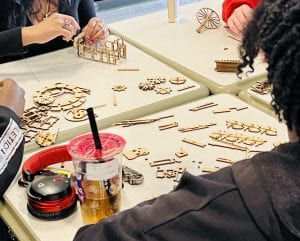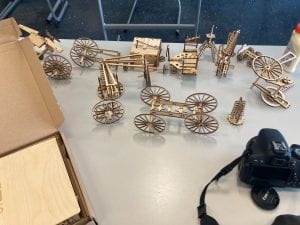By Omar Badessi, Ph.D.
Language Instructor
Department of Hispanic Languages and Literature
As an educator and music enthusiast, I firmly believe in harnessing the transformative power of music to cultivate inclusive learning environments both within the classroom and beyond (Harwood, 2010). Music, with its universal language, serves as a bridge connecting students from diverse backgrounds while also fostering empathy, understanding, and collaboration.

Embracing a Global Soundscape
My approach to incorporating music into the classroom begins with immersing students in the rich tapestry of global musical traditions. Utilizing music platforms and recordings, I introduce students to a diverse array of Spanish and Arabic genres and instruments from North Africa, Latin America, the Middle East, Europe, and beyond. Through listening sessions and open discussions about the lyrics and context of the songs, students explore the origins, instrumentation, and cultural significance of various musical expressions. This not only sparks curiosity but also cultivates cultural appreciation and encourages dialogue about our shared humanity amidst diverse musical landscapes (National Association for Music Education, 2023).
Celebrating Student Identities
Moving beyond passive engagement, I invite students to share music from their own cultural backgrounds. Whether it’s through presentations like “Ventana Cultural” (cultural windows), Karaoke Nights activities, sharing hobbies and passions through the “Amigos de Omar أصدقاء عمر “ newsletter, or participating in live performances such as “A Star is Born,” students are encouraged to express themselves musically while celebrating their unique cultural identities. These experiences promote empathy, understanding, and active participation in shaping the classroom’s cultural tapestry (Edwards, 2022).

Music for Social-Emotional Learning (SEL)
Moreover, music serves as a powerful tool for social-emotional learning (SEL). Collaborative songwriting activities centered on themes like empathy and understanding allow students to express themselves creatively while honing essential social and emotional skills. Through shared musical experiences, students develop communication skills, emotional intelligence, and a sense of belonging within the classroom community (The Journal of Music Therapy, 2021).
Music as a Bridge for Collaboration
Outside of class, musical rehearsals or live performances are a great opportunity for different people to connect and collaborate with each other.. These activities promote teamwork, cultural exploration, and a deeper appreciation for diverse musical heritages (Higgins & Jones, 2020). Personally, I cherish memories of collaborating with musicians from various cultural backgrounds at Stony Brook University, like playing the drums for the cross-cultural ensemble Lost in Staller, which mixed classic and funky-Afro beats while exploring jazz tension between composition and improvisation. Here is a recording of a Spanglish performance: Besame con frenesí.
The Stony Brook Broadway Orchestra (SBBO) further exemplifies the power of music to unite students from diverse cultural backgrounds. Each final show, supported by families and friends, showcases the talents of our community. Shows such as Annie Get your Gun, The Addams Family, or Big Fish, leave lasting impressions and fond memories. Check out our rendition of The Lightning Thief.
In conclusion, music serves as a catalyst for cultural understanding, emotional exploration, and collaborative learning. By integrating diverse musical experiences into the classroom, educators create vibrant and inclusive environments where every student’s voice is valued and celebrated. Music becomes more than just a subject—it becomes a vehicle for enriching the educational journey for all.
References:
Edwards, M. R. (2022). *Building inclusive music classrooms: A guide for general music teachers*. Oxford University Press.
Harwood, J. (2010). “The Power of Song: The Cultural and Pedagogical Functions of Song in the EFL Classroom.” Tesol Quarterly, 44(4), 617-640.
Higgins, L., & Jones, E. (2020). *Inclusive musical practice in education: Embracing all learners*. Routledge.
National Association for Music Education. (2023). *Music & social justice: Educators guide*.
The Journal of Music Therapy. (2021). *The power of music in inclusive education*, 58(2), 123-142.









